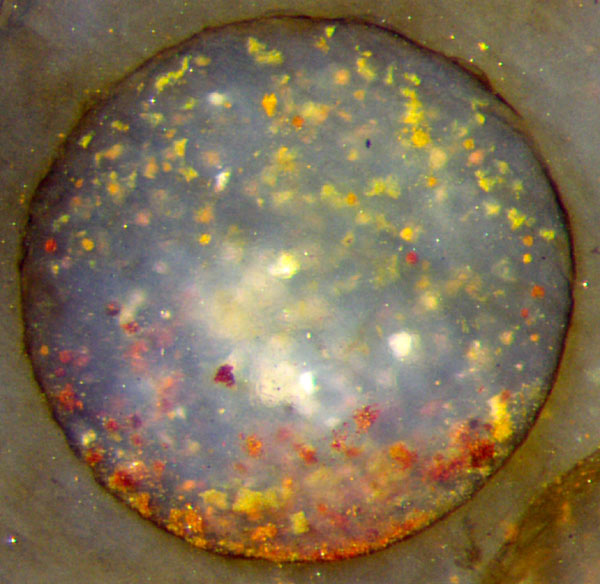Miniature fossil sewage tank
Sewage treatment, of course, is not an invention of Man. So it should
not be surprising to find some fossil evidence of this process but it
would be difficult to recognize it as such. Hence, what may be regarded
as a fossil model of a sewage treatment tank, nicely shaped as a tiny
sphere as seen
in this image, deserves closer inspection.

The spherical tank is a "chlamydospore"
of one of several fungus species preserved in the Lower Devonian Rhynie
chert. Chlamydospores are not analogous to the dust-like spores known
from mushrooms. They grow on the filamentous fungus hyphae and are filled
with reserve stuff which enables them to outlive the hyphae in case
the latter die and decay. In
some samples
the fossil chlamydospores
are found in several sizes corresponding to the species,
often not quite spherical, and occasionally numerous. Most
often they are no more attached to a hypha. Hyphae without
chlamydospores
are a common sight in the Rhynie chert
(see
Rhynie
Chert News 77,
78)
but rare in other cherts.
The chlamydospore seen here is an exceptionally big
one, diameter
0.75mm. Possibly it died
before new hyphae could grow from it,
and the organic substance inside decayed and turned into "sewage". The
overall aspect suggests that microbes had grown
inside and clustered into floating floccules similar to
those known from sewage treatment plants.
Apparently, iron ions from decay products formed
oxides which settled on the floccules, thereby staining them yellow and
red. The heavier floccules, preferably the red ones, sank to the bottom
before all got fixed by the formation of silica gel. Gel formation was
facilitated by diffusion of dissolved silica through the wall and
favoured by the lower pH caused by the decay products inside.
The subsequent progress of silicification seems to have followed the
usual path: more diffusion of dissolved silica into the gel making the
gel stiffer and causing the water to diffuse outward until the present
state of translucent bluish chalzedony had been reached.
Finally it be mentioned that the probabilty of finding a
big fossil chlamydospore
like this one, colourful and incidentally cut
into halves, is extremely low.
Sample: 0.55kg, found by
Sieglinde Weiss in 2014.
H.-J.
Weiss
2015
 |
 |
84 |




